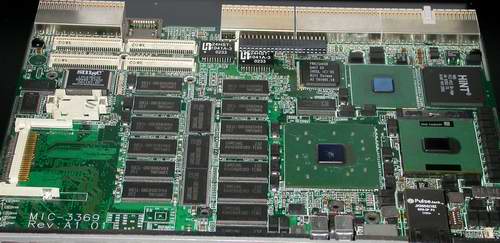
Original Link: https://www.anandtech.com/show/1071
Intel Developer Forum Spring 2003 - Technology Showcase
by Anand Lal Shimpi on February 19, 2003 12:51 PM EST- Posted in
- Trade Shows
This article first appeared on the AnandTech Newsletter. Click Here to Sign Up.
The Technology Showcase at the Intel Developer Forum is always a very interesting place to learn about next-generation technologies, especially since Intel has loosened their grip on what exhibitors can and can't show on the floor. While it used to be the case that you wouldn't see any unreleased Intel products on the exhibition floor, today we were able to see everything from Centrino notebooks to 800MHz FSB Pentium 4 processors running on 865 and 875 platforms.
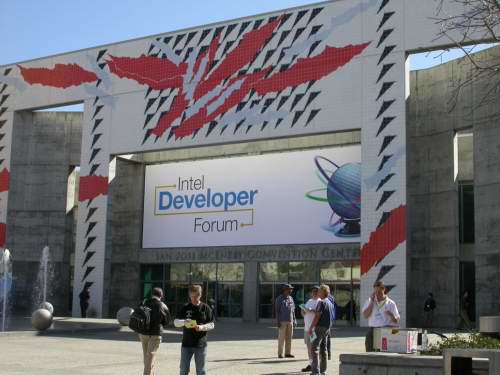
But in the usual IDF fashion, we'll provide coverage from a company that you almost always see around this time of the year - AMD.
AMD, Not much to Show
AMD almost never fails to make it to IDF; obviously not as an exhibitor at the Technology Showcase, but as a guest in one of the hotels around the convention center. This year it was the Fairmont hotel where we found AMD with their suite of Hammer and Barton demos, the most interesting of which was the proof of concept Mobile Athlon 64 notebook:
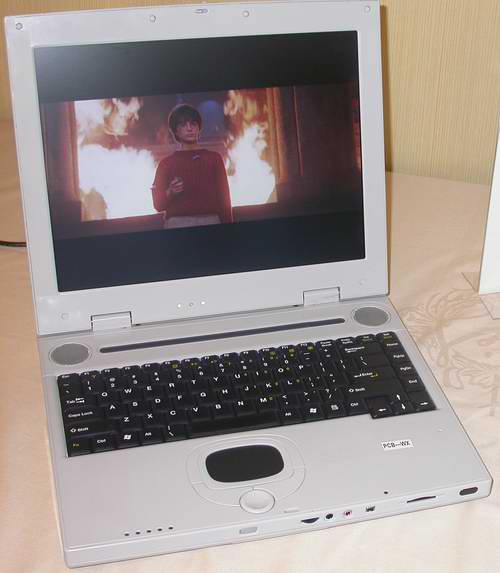
The Mobile Athlon 64 processor is basically the desktop Athlon 64 but with PowerNow enabled; the processor uses the same 754-pin packaging and this proof of concept notebook was running VIA's K8 chipset.
From talking to AMD we've gathered that the Athlon 64 package could be shrunk in theory for use in thin form factor applications. Whenever you have a brand new CPU, especially in the case of AMD's overly delayed Athlon 64, there are a number of power and ground pins that are excessive simply because the design isn't optimized in its first revision. The ~40 or so pins that could be eliminated in the 754-pin Athlon 64 design could aid in reducing the size of the Mobile Athlon 64, but with the release of the part not scheduled until September of this year, it's entirely too early to start talking about future revisions of the chip.
AMD's proof of concept is nice but at this point we're growing weary of seeing Hammer demonstrations without product availability. Remember, it was exactly one year ago that we first saw Hammer in action at IDF; a full year has gone by and it will be another several months before we see retail availability of desktop parts.
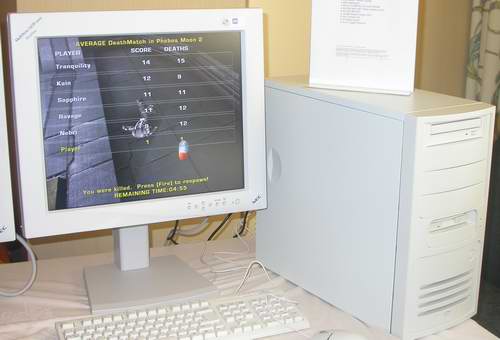
AMD had an updated version of Epic's 64-bit Unreal Tournament 2003 running on Athlon 64 hardware, similar to what we've seen in the past. Epic has been a strong supporter of x86-64 and AMD's Athlon 64, mainly because of the dead-end they see with Itanium and the upside to 64-bit memory addressability in the desktop/workstation sectors - thus it's no surprise that we see continued support from them for Athlon 64.
AMD - Not Much to Show (continued)
Bringing the Hammer line full circle, we have AMD's Opteron:
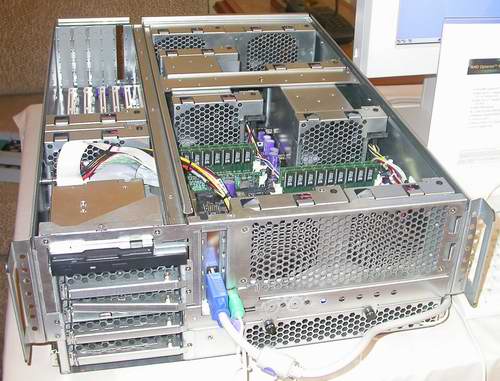
AMD has shown off their 4-way Opteron server numerous times, in this case we have the same system we've seen before but we've never brought up-close-and-personal pictures of it so here you go.
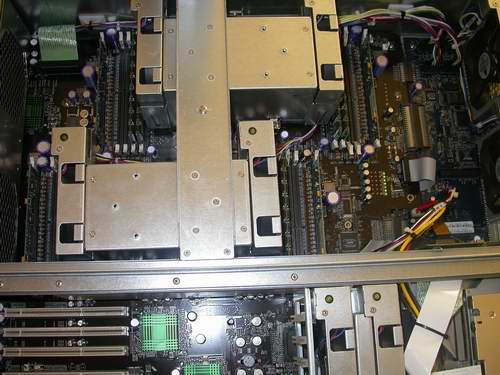
The two metal enclosures you see in the overhead shot are the cooling bays for the four Opteron processors, most likely running at 1.4GHz. We asked AMD if we could expect to see the same clock speed targets (read: ~2GHz) for the Opteron's launch on April 22nd as we were told to expect for the Athlon 64, but we were given the response that the Opteron user base is not as sensitive to clock speeds as the Athlon 64 user base is. In short, AMD doesn't have to launch the Opteron at ~2GHz targets if they don't want to; in our opinion, AMD would if they could, so only time will tell what we see on April 22nd. AMD told us that there will be three Opteron speeds on April 22nd, two of which will be immediately available with one following a month or so later; they also insisted that they will have the fastest 32-bit server CPU upon their launch.
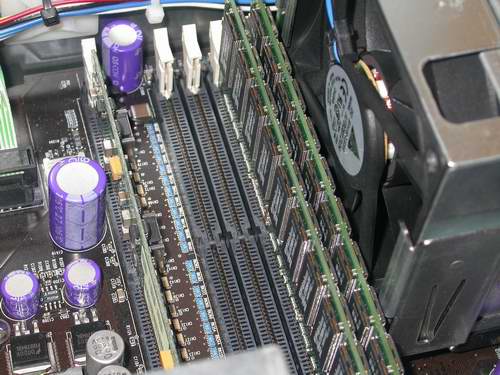
Each one of the four Opteron CPUs has their own dedicated memory controller, and this particular board design calls for each CPU to have 4 total DIMM slots; remember that the Opteron has a dual channel DDR memory controller, so memory must be installed in pairs as you can see above. The slot towards the left of the picture above isn't for a fifth DIMM, but rather the voltage regulator circuitry for the set of memory slots. AMD wanted to save space on the reference board, which is why they placed the VRM circuitry for the memory banks on these risers instead of on the board itself - by no means is it anything that should be commonplace to all Opteron boards, it's just what AMD decided to do in this case.
The final demonstration AMD had was actually of their Athlon XP 3000+ up against Intel's 3.06GHz Pentium 4:
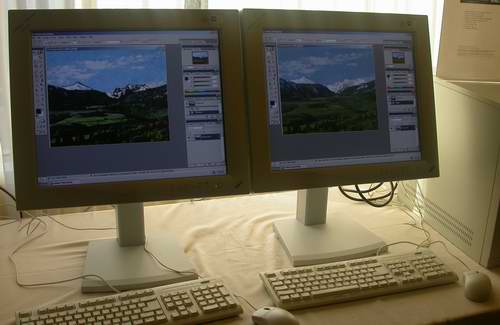
The demo was using Intel's Hyper-Threading Photoshop script, apparently from Intel's website, and showed the Athlon XP 3000+ outperforming the Pentium 4 3.06. As you will remember from our review of the Athlon XP 3000+, there are definitely situations where it can outperform the 3.06GHz Pentium 4 - but at the same time, there are even more situations where the Pentium 4 can outperform it.
Intel's 865 & 875
As we mentioned in the Newsletter yesterday, Intel's Springdale and Canterwood chipsets will be called the 865 and 875 respectively. Their features are best summarized by the following table:
|
Intel
Chipsets in 2003
|
||||
|
Chipset:
|
865P
(Springdale-P)
|
865PE
(Springdale-PE)
|
865G
(Springdale-G)
|
875
(Canterwood)
|
| Release Timeframe |
May
|
May
|
May
|
May
|
| FSB Support |
533/400MHz
|
800/533MHz
|
800/533MHz
|
800/533MHz
|
| Memory Support |
Dual
DDR266/333
|
Dual
DDR333/400
|
Dual
DDR333/400
|
Dual
DDR333/400
|
| Graphics Support |
AGP
8X
|
AGP
8X
|
AGP
8X
845GE Graphics core |
AGP
8X
|
| Additional Features |
Replaces
845PE Chipset
ICH5 w/ Serial ATA Support |
Replaces
845PE Chipset
ICH5 w/ Serial ATA Support |
Replaces
845G/GE Chipset
ICH5 w/ Serial ATA Support |
Replaces
850E Chipset
"Turbo Mode" ICH5 w/ Serial ATA Support ECC Memory Support |
Intel had a number of 865 motherboards running at the Technology Showcase, mainly in their Powersville concept PC designs:
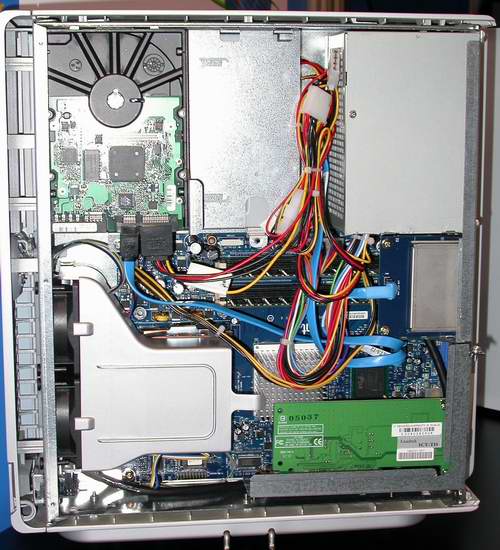
Intel's Powersville motherboard fits the new Bigwater form factor that Intel announced a year ago; the purpose of this motherboard was to develop a proof of concept of the Bigwater layout with a next-generation Pentium 4 platform, in this case the 865 chipset with a Pentium 4 3.0GHz (800MHz FSB).
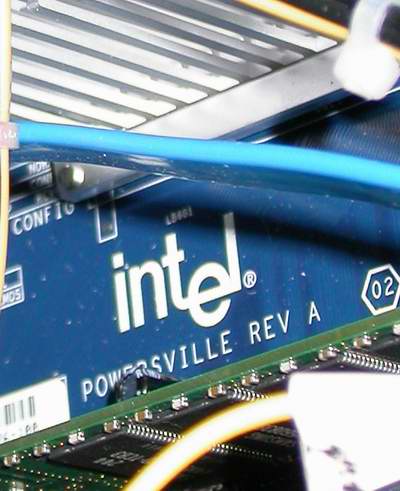
The 865MCH had a massive heatsink, much larger than anything we've ever seen on a desktop chipset before - partially because of the fact that it is still using passive cooling:
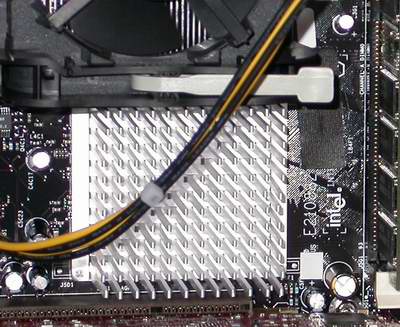
Looking at the motherboard, you can see that it has native Serial ATA support built onto the board itself; closer inspection reveals that there's no external controller, and that the Serial ATA is running natively through the South Bridge (ICH5).
Intel's ICH5
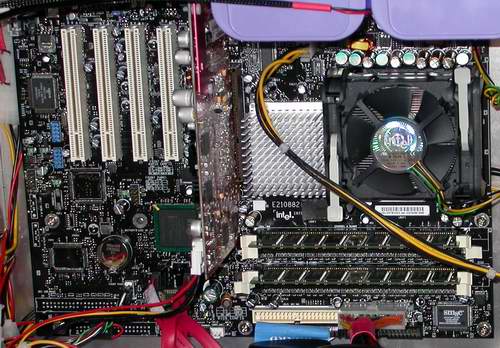
The beauty of native Serial ATA in ICH5 is that the interface does not clog up the PCI bus nor is it limited by the 133MB/s bandwidth limitation of current 32-bit/33MHz PCI, which in theory will lead to better performance for Serial ATA devices.
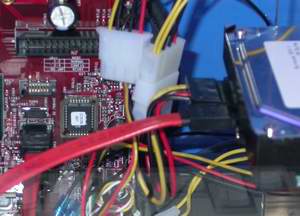
ICH5 features two Serial ATA 150 channels as well as two conventional Parallel ATA channels:
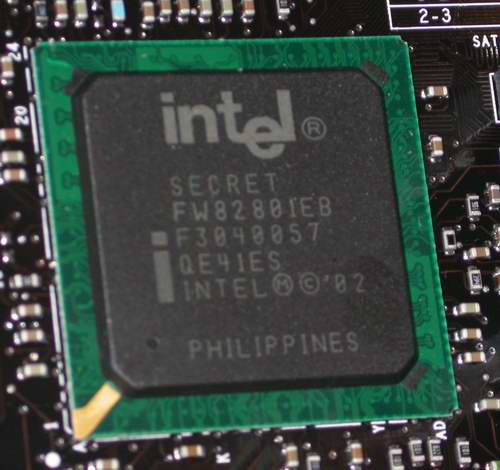
Intel's ICH5
Another feature of this new ICH is Intel's new Serial ATA RAID; what's special about Intel's Serial ATA RAID is that, for starters, it is built into the ICH and will interface perfectly with Intel's Application Accelerator. Quite possibly the most attractive feature of the solution is that it will allow you to upgrade a single drive to a dual drive RAID-0 array, without reinstalling your OS.
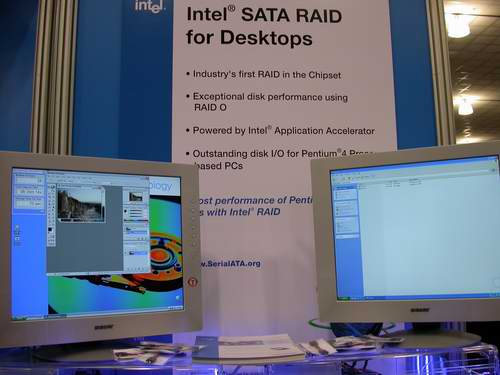
The process is simple; you first setup your system with a single Serial ATA drive. When you're ready to move to RAID-0 you just add the new drive, and tell the Intel Application Accelerator utility that you'd like to create a RAID-0 array. Intel's software will take over and create the new striped array without causing any dataloss, which is something that we would've expected to see in the past from other IDE RAID vendors.
With Intel providing Serial ATA RAID support in their forthcoming ICH5, you can say goodbye to solutions from Silicon Image, Promise and Highpoint on motherboards. Interestingly enough, ICH5 will only support RAID-0 at launch.
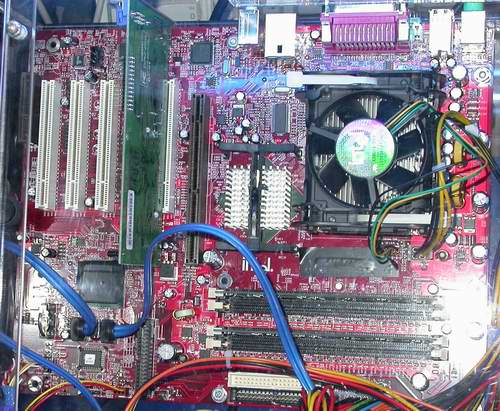
We closed off with a look at Intel's 875 chipset
More on New Platforms
In our coverage of the first day of the Spring 2003 IDF we talked about Intel's Powersville concept PC, today we're able to bring you a bit more on the concept PC side:
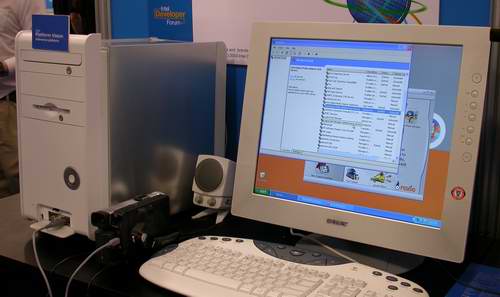
Above we have the 2003 Concept PC called Statesboro, designed to be an attractive digital media PC. This particular machine is Hyper-Threading enabled and sports a very attractive and simple chassis:
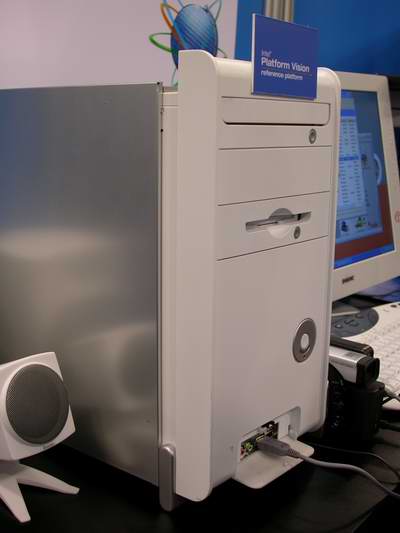
The more interesting concepts came from the 875 based systems Intel had on display, that showcased the Serial ATA enabled ICH5:
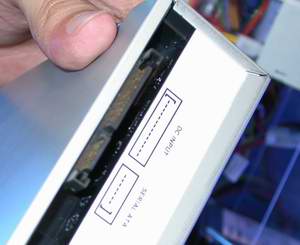
We were able to see prototypes of native Serial ATA CD/DVD-RW drives such as the one pictured above.
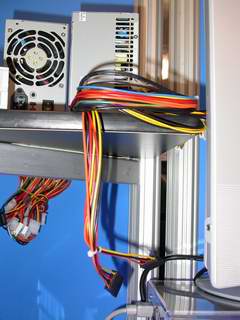 |
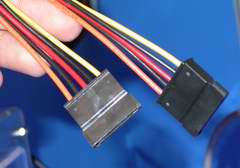 |
Intel also had on display a next-generation power supply with the native Serial ATA power connectors coming directly from the power supply itself. Currently you either have to use a 12V/5V to Serial ATA power converter cable, or you have to find a Serial ATA hard drive with both Serial ATA and regular power connectors in order to power your SATA drives. The beauty of having these connectors native on your power supply is that they carry all three voltages, 12V, 5V and the new 3.3V drive standard. With enough of these connectors making it to power supplies, the transition to 3.3V signaling for hard drives will be made with less difficulty.
Although not pictured here, Intel did have some more to say about PCI Express. According to Louis Burns, Intel expects to have native PCI Express support in platforms by 2004, which we think is fairly optimistic seeing as there will be a very limited number of PCI Express devices within that timeframe.
Rambus - Not much on the Desktop Side
As usual Rambus was a Gold Sponsor of the Intel Developer Forum, and with Intel pushing only their dual channel DDR platform designs it's not a surprise that the majority of what we saw at Rambus wasn't related to desktop PC chipsets:
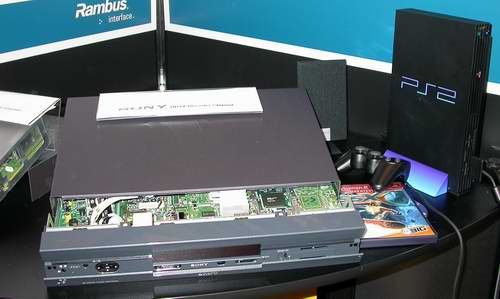
Consumer and network applications were prime targets for RDRAM's high bandwidth and extremely granular architecture, which we continued to see at the Technology Showcase.
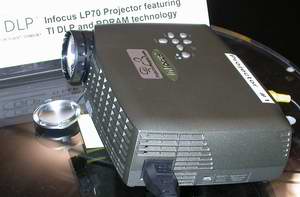
Device such as this Digital Light Projector pictured above, are applications for RDRAM that you normally wouldn't think of.
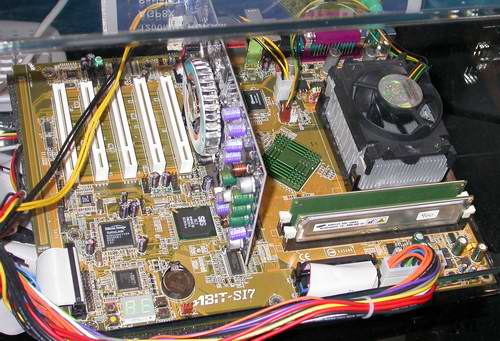
Rambus did have an ABIT motherboard based on SiS' R658 dual channel RDRAM solution up and running. This particular board supports RDRAM with speeds of up to 1200MHz, which is quite impressive but it's a shame that Intel won't be using the technology anytime soon.
What's even more interesting is the R659 chipset, a quad-channel RDRAM chipset due out by the end of this year from SiS. The beauty of the R659 is that you can use four channels of cheap PC800 RDRAM and still obtain the same 6.4GB/s of memory bandwidth that Intel's dual channel DDR400 865/875 platforms will offer, but with much easier board layout. Unfortunately without Intel's backing, it's unlikely that quad-channel RDRAM will ever take off with the Pentium 4 - not unless SiS is hugely successful with the R659.
Pentium M & Centrino on Display
The talk of the town is Intel's Pentium M processor, which is a part of the Centrino mobile architecture.
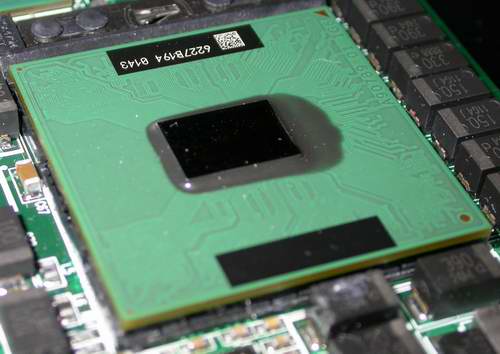
Intel's Pentium M Processor
The Pentium M is the processor that was formerly known as Banias, and is essentially an updated Pentium III core, with a 1MB L2 cache and a 400MHz Pentium 4 FSB. The fact that the Pentium M uses the same FSB as the Pentium 4 means that it can interface with existing Pentium 4 chipsets, which is why we were able to see this demonstration of a server running the Intel 7501 chipset and a Pentium M processor:
The purpose of this demonstration was to show off the capabilities of a low power server microprocessor. Power consumption is an important thing to take into account in the server world, especially once you realize that having hundreds of 2-way Xeons or Athlon MPs can significantly impact power costs, especially in a collocation center. Power hungry servers also are harder to ensure uptime on as you have to make certain you have more powerful battery backups in the event of a power failure.
Intel also had a number of Centrino notebooks on display, most of which were running 1.6GHz Pentium M processors:
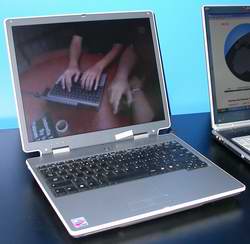 |
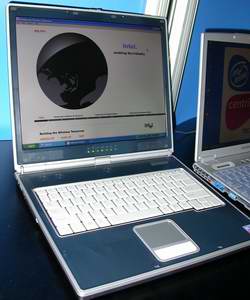 |
The more impressive demo came from Samsung, who has done a relatively unique design for the Centrino platform:
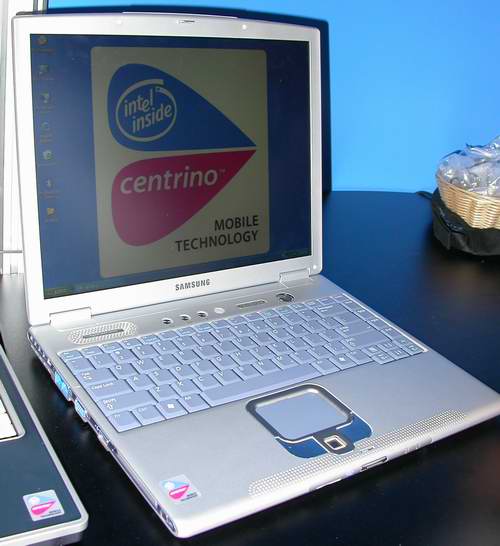
This Samsung thin-and-light not only boasts an attractive form factor, but in theory takes advantage of all that the Centrino mobile technology has to offer. Only time will tell if these notebooks are all Intel says they are cracked up to be; March 12th is the official launch of Centrino, so as usual, we'll let you know as soon as we find out for ourselves.
More Centrino
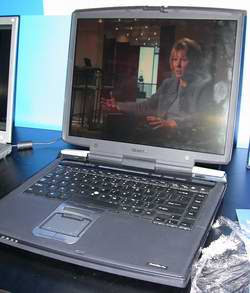 |
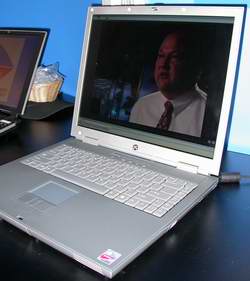 |
Toshiba had a version of their ultra small form factor notebook outfitted in Centrino garb:

It will be a short while before manufacturers start offering notebooks designed entirely around the Centrino mobile technology, but Intel's marketing dollars are too great to resist so you can expect to see a number of Centrino optimized designs in the coming months and especially over the next two years.
Serial ATA II - Port Multipliers
Our final stop for the night leads us to another look at Serial ATA II, in particular one feature of the spec known as a port multiplier.
One of the biggest complaints about the Serial ATA spec is that you can only have one device per channel, meaning that if you want 6 Serial ATA drives, you'll need 6 Serial ATA connectors and 6 cables. This isn't a huge deal for desktop systems, but in servers where more than 6 drives is a possibility, it does become a concern.
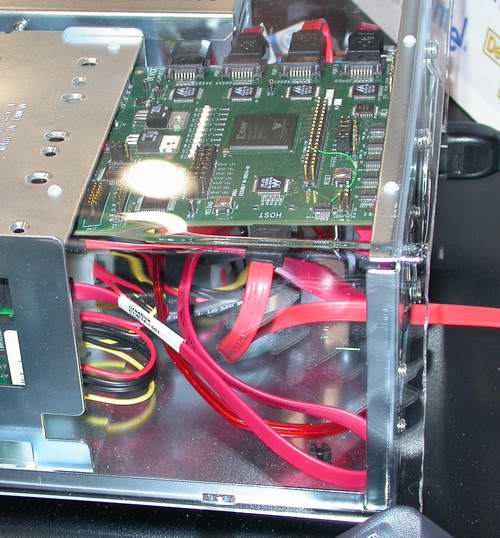
A crude implementation of what a Serial ATA II Port Multiplier can do, the
mass market solution could be significantly smaller in size
One solution to the problem is defined in the Serial ATA II spec through port multipliers. As the name implies, a port multiplier will take one Serial ATA channel and share the bandwidth with up to 15 devices. All that is necessary is a small piece of silicon and the extra connectors, and you essentially have a Serial ATA switch that lets you connect multiple drives to a single Serial ATA connector. Remember that you're sharing the bandwidth of this single Serial ATA link, which at current point is only 150MB/s; if split among 10 drives, 150MB/s is no longer anything to write home about, but with Serial ATA II we'll be dealing with much higher bandwidths when the technology surfaces in the market, so the 150MB/s limit won't be a concern.
Final Words
There's very little left at the Technology Showcase, so you can expect coverage from the keynotes and special sessions for the rest of the week as we continue to cover the Spring 2003 Intel Developer Forum. As usual, stay tuned...

